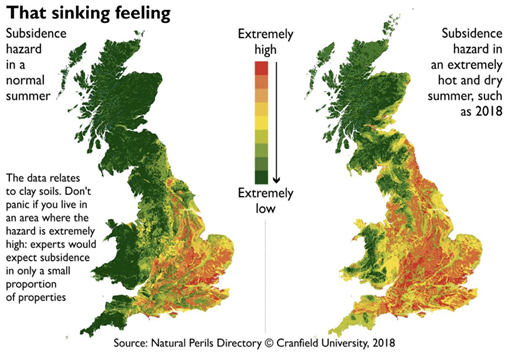Sizzling summer sparks subsidence shockwave
More than 10,000 households made claims worth a total of £64 million to deal with the impact of subsidence in just three months of this year, the Association of British Insurers (ABI) is revealing today.
The figures for July, August and September are the highest level of subsidence claims since the record-breaking heatwaves of 2006 and 2003. The hot weather of 2018 saw some UK regions experience the driest months on record, particularly in the South East which is also well-known for building on subsidence-prone clay soil.
From the previous quarter, the number of claims jumped from 2,500 to 10,000 – rising in value from £14 million to £64 million. This increase of 350% is the highest quarter-on-quarter jump since records began more than 25 years ago.
The ABI’s Senior Policy Adviser for Property, Laura Hughes, said:
“Thousands of people across the UK are now suffering because we experienced such an unprecedented period of dryness this summer. Insurers understand that this is a stressful time for affected homeowners and are providing widespread support to help with repairs.
“Our advice is don’t panic if you spot a crack in your home – there are many other reasons why these may have occurred. Get in touch with your insurer if you believe your home is experiencing subsidence and they’ll be on hand with the best expertise and the best technology. Insurers and their appointed loss adjusters are very well equipped to deal with these types of complex claim.”
Subsidence usually occurs when the ground beneath a building loses moisture and shrinks. This can be caused by a number of things including prolonged dry spells which cause soil to lose water and trees and shrubs which can absorb significant volumes of water from the soil.
The ABI has also provided the following advice on how to tell the difference between subsidence and general wear and tear:
- Subsidence cracks usually appear very suddenly, rather than gradually;
- They are usually diagonal, and wider at the top than the bottom;
- They tend to be thicker than a 10p coin;
- They are often found around doors and windows;
- Subsidence may also cause dry wallpaper to rip or crinkle and;
- doors and windows may start to stick.
Subsidence is routinely covered by buildings insurance. Each claim is unique depending on the building, circumstance and severity involved so there is no typical approach to repairs
In some extreme cases your home may need to be monitored for a period of time. If your home is uninhabitable during this process – your insurer will cover the cost of alternative accommodation until you are able to move back in.

Read Crawford’s report: “Subsidence: The Silent Surge”
-ENDS-
Notes for Editors
Enquiries to:
Malcolm Tarling 020 7216 7410 Mobile: 07776 147667
Sarah Cordey 020 7216 7375 Mobile: 07860 189071
Dominic Stannard 020 7216 7350 Mobile: 07725 245838
- The Association of British Insurers is the voice of the UK’s world leading insurance and long-term savings industry.
A productive, inclusive and thriving sector, we are an industry that provides peace of mind to households and businesses across the UK and powers the growth of local and regional economies by enabling trade, risk taking, investment and innovation.
2. An ISDN line is available for broadcast
3. More news and information from the ABI is available on our web site, www.abi.org.uk.
